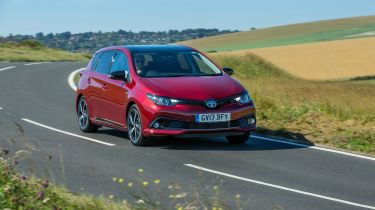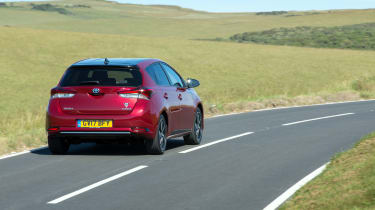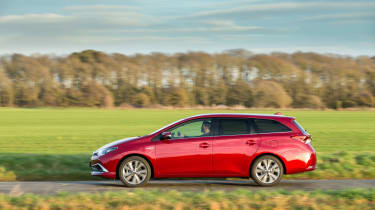Used Toyota Auris Hybrid Mk2 buying guide
All you need to know about buying a used Toyota Auris Hybrid Mk2, produced from 2012 to 2019

When it comes to hybrid technology, Toyota is the master. It was was the first company to put a mainstream hybrid production car on the market, with the original Prius in 1997 – and since then it has sold more than 10 million petrol-electric hybrid cars.
While the original Prius didn't make it to the UK officially, its successors did and the Prius has been a huge success here since the first examples were sold in 2000. In the intervening years, Toyota has introduced numerous hybrid versions of its more mainstream models, including the Yaris and the first-generation Auris – as well as the Auris Mk2, which we're covering here. As such the Auris was the first model in its class to be offered in hybrid form.
History
October 2006: The Auris Mk1 arrives in the UK.
March 2010: The first-generation Auris Hybrid reaches UK showrooms.
December 2012: The Auris Mk2 makes its debut, with a hybrid model available from the outset. The car is made in Toyota's plant at Burnaston in Derbyshire. At the heart of the Auris is a 1.8-litre petrol engine backed up by an electric motor; combined, they provide peak power of 134bhp. The electric-only range is just 1.2 miles, at up to 31mph, due to the fitment of a very small battery pack.
February 2013: An Auris Hybrid estate goes on sale, called the Auris Touring Sports. It's mechanically identical to the hatchback, but 265mm longer (4,595mm compared to 4,330).
March 2013: The Auris Hybrid Icon hatchback's CO2 emissions are cut to 84g/km, while those of the Icon Touring Sports are now 85g/km – a cut of just 1g/km.
March 2015: A facelift brings revised trim levels, which are now Active, Icon, Business Edition, Design and Excel; they're all available in Hybrid form. The exterior design is updated, the dashboard is redesigned, the interior gets higher-quality materials and there are tweaks to the steering and suspension to improve the driving experience. CO2 emissions are also cut slightly, while fuel economy is marginally improved.

Which one should you buy?
All Auris Hybrids are the same mechanically, so it's just a question of choosing which trim level suits you best. Whereas the regular Auris was initially available in Active, Icon, Sport and Excel forms, the Hybrid came only as Icon or Excel.
The Icon features 15-inch alloys, a rear parking camera, a six-speaker infotainment system, Bluetooth and DAB, plus powered windows all round and power-adjustable, heated door mirrors and climate control.
To all of this, the Icon adds 17-inch alloys, privacy glass, automatic lights and wipers, dual-zone climate control, heated front seats, cruise control, retractable door mirrors and Intelligent Parking Assist, which also includes front and rear parking sensors.
Navigation is an option throughout the range, while Intelligent Park Assist is extra on the Icon. The two key options on the Auris Hybrid Excel are leather trim and a panoramic roof.

Alternatives
The closest rival to the Auris Hybrid is the Toyota Prius, not least because the two cars are pretty much the same under the metal. However, while the Auris comes only as a regular hybrid with a small battery pack, a plug-in version of the Prius is available; this offers a much greater electric-only range.

A leftfield choice is the Vauxhall Ampera, which is a range extender rather than a plug-in hybrid. This means the engine acts almost exclusively as an on-board generator to keep the battery topped up, although at high speeds the engine does drive the front wheels, in conjunction with the twin electric motors.
Like the Auris Hybrid, the Ampera arrived in 2012 and it's quite dated now, but it offers hatchback practicality with ample space for four – but only four, as the rear seats are individual sculpted items.

Verdict
The Auris Hybrid is a typical Toyota through and through, which means it's a mixture of good and bad. The good news is that the ownership experience should be painless thanks to excellent reliability and very low running costs, while the Auris is also easy to drive and very practical.
On the downside it's not very engaging to drive and the interior feels a little downmarket, especially if you're buying lower down the range. But with more than half of Auris sales across Europe being of the Hybrid edition, Toyota clearly got something right.
Checklist
- The Auris was the first hybrid small family hatchback – and it shows. The interior design is looking increasingly dated these days.
- You'll find the Auris Hybrid is an easy car to drive but you won't relish the thought of getting behind the wheel, as it's pretty unexciting dynamically, with vague steering and a disappointingly wallowy ride.
- Although Toyota claims that you can get up to 80mpg from an Auris Hybrid, the reality is that you'll struggle to get more than 60 – and 45mpg is quite likely if you do more high-speed long-distance drives.
- In many hybrids, the battery pack eats into the boot space, but not in the Auris, because the battery fits under the rear seat. As a result, boot space is identical for all Auris hatchbacks at 412 litres with the seats up or 767 with them down; for the Touring Sports, this rises to 649 or 1,635 litres.
- The Auris Hybrid hatchback isn't homologated for towing, but the Touring Sports is. It can tow only up to 345kg, though.
- Reliability is Toyota's strongest suit and aside from the odd creak, squeak or rattle from the trim you're unlikely to encounter any problems with an Auris Hybrid that's been looked after.
Recalls
August 2015: The inverter assembly can overheat, leading to the car to resort to limp-home mode or stopping it altogether.
August 2016: Some cars were made with faulty headlights, which didn't illuminate the way ahead correctly.
September 2016: The emission control unit near the fuel tank could leak, leading to the possibility of a vehicle fire.
January 2019: A software glitch with the electronic control unit could lead to the car not going into failsafe mode in the event of some hybrid faults occurring.

Running costs
Insurance groups: 7-12
Average mpg: 72-80mpg (hatchback), 70-80mpg (estate)
CO2 emissions: 79-91g/km (hatchback), 81-92g/km (estate)
The Auris Hybrid comes with a five-year/100,000-mile warranty as a whole, but the battery pack is guaranteed for eight years/100,000 miles. The Auris Hybrid's maintenance intervals are pegged at every 12 months or 10,000 miles, with the services alternating between minor and major.
At the time of writing (October 2019) these were priced at £190 and £340 respectively. The Auris Hybrid's engine isn't fitted with a timing chain, so there's no cambelt to replace, which helps to reduce maintenance costs.
Most Popular

Morgan Super3 XP-1 is an electric three-wheeler

MINI Cooper Electric: pricing and specs for British-built electric supermini
